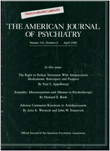Biopsychosocial characteristics of children who later murder: a prospective study
Abstract
The authors document the childhood neuropsychiatric and family characteristics of nine male subjects who were clinically evaluated as adolescents and were later arrested for murder. Those subjects are compared with 24 incarcerated delinquents who did not go on to commit violent offenses. The future murderers displayed a constellation of biopsychosocial characteristics that included psychotic symptoms, major neurological impairment, a psychotic first-degree relative, violent acts during childhood, and severe physical abuse. The authors relate this combination of factors to prediction of violence and discuss ethical issues that are involved in intervention to prevent violence.
Access content
To read the fulltext, please use one of the options below to sign in or purchase access.- Personal login
- Institutional Login
- Sign in via OpenAthens
- Register for access
-
Please login/register if you wish to pair your device and check access availability.
Not a subscriber?
PsychiatryOnline subscription options offer access to the DSM-5 library, books, journals, CME, and patient resources. This all-in-one virtual library provides psychiatrists and mental health professionals with key resources for diagnosis, treatment, research, and professional development.
Need more help? PsychiatryOnline Customer Service may be reached by emailing [email protected] or by calling 800-368-5777 (in the U.S.) or 703-907-7322 (outside the U.S.).



